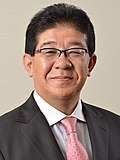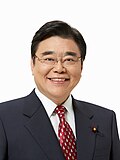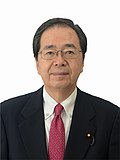| Portfolio | | Image | Minister | | Term | Note |
|---|
| Cabinet ministers |
| Prime Minister | |  | Fumio Kishida | R | 4 October 2021 – 1 October 2024 | |
|---|
| Minister for Internal Affairs and Communications | |  | Junji Suzuki | R | 13 September 2023 – 14 December 2023 | First cabinet appointment [28] |
|---|
|  | Takeaki Matsumoto | R | 14 December 2023 – 1 October 2024 | |
|---|
| Minister of Justice | |  | Ryuji Koizumi | R | 13 September 2023 – 1 October 2024 | First cabinet appointment [28] |
|---|
| Minister for Foreign Affairs | | 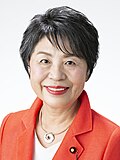 | Yoko Kamikawa | R | 13 September 2023 – 1 October 2024 | |
|---|
Minister of Finance
Minister of State for Financial Services
Minister in charge of Overcoming Deflation | | 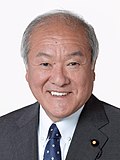 | Shun'ichi Suzuki | R | 4 October 2021 – 1 October 2024 | |
|---|
| Minister of Education, Culture, Sports, Science and Technology | |  | Masahito Moriyama | R | 13 September 2023 – 1 October 2024 | First cabinet appointment [28] |
|---|
| Minister of Health, Labour and Welfare | |  | Keizo Takemi | C | 13 September 2023 – 1 October 2024 | First cabinet appointment [28] |
|---|
| Minister of Agriculture, Forestry and Fisheries | |  | Ichiro Miyashita | R | 13 September 2023 – 14 December 2023 | First cabinet appointment [28] |
|---|
|  | Tetsushi Sakamoto | R | 14 December 2023 – 1 October 2024 | |
|---|
Minister of Economy, Trade and Industry
Minister in charge of the Response to the Economic Impact caused by the Nuclear Accident
Minister for Green Transformation
Minister in charge of Industrial Competitiveness
Minister for Economic Cooperation with Russia
Minister of State for the Nuclear Damage Compensation and Decommissioning Facilitation Corporation | |  | Yasutoshi Nishimura | R | 10 August 2022 – 14 December 2023 | |
|---|
|  | Ken Saitō | R | 14 December 2023 – 1 October 2024 | |
|---|
Minister of Land, Infrastructure, Transport and Tourism
Minister in charge of Water Cycle Policy
Minister for the World Horticultural Exhibition Yokohama 2027 | |  | Tetsuo Saito | R | 4 October 2021 – 1 October 2024 | |
|---|
Minister of the Environment
Minister of State for Nuclear Emergency Preparedness | |  | Shintaro Ito | R | 13 September 2023 – 1 October 2024 | First cabinet appointment [28] |
|---|
| Minister of Defense | |  | Minoru Kihara | R | 13 September 2023 – 1 October 2024 | First cabinet appointment [28] |
|---|
Chief Cabinet Secretary
Minister in charge of Mitigating the Impact of U.S. Forces in Okinawa
Minister in charge of the Abductions Issue | |  | Hirokazu Matsuno | R | 4 October 2021 – 14 December 2023 | |
|---|
|  | Yoshimasa Hayashi | R | 14 December 2023 – 1 October 2024 | |
|---|
Minister for Digital Transformation
Minister in charge of Digital Administrative and Fiscal Reforms
Minister in charge of Digital Garden City Nation Vision
Minister in charge of Administrative Reform
Minister in charge of Civil Service Reform
Minister of State for Regulatory Reform | |  | Taro Kono | R | 10 August 2022 – 1 October 2024 | |
|---|
Minister of Reconstruction
Minister in charge of Comprehensive Policy Coordination for Revival from the Nuclear Accident at Fukushima | |  | Shinako Tsuchiya | R | 13 September 2023 – 1 October 2024 | First cabinet appointment [28] |
|---|
Chairman of the National Public Safety Commission
Minister in charge of Building National Resilience
Minister in charge of Territorial Issues
Minister of State for Disaster Management and Ocean Policy | |  | Yoshifumi Matsumura | C | 13 September 2023 – 1 October 2024 | First cabinet appointment [28] |
|---|
Minister of State for Policies Related to Children
Minister of State for Measures for Declining Birthrate
Minister of State for Youth's Empowerment
Minister of State for Gender Equality
Minister in charge of Women's Empowerment
Minister in charge of Cohesive Society
Minister in charge of Measures for Loneliness and Isolation | |  | Ayuko Kato | R | 13 September 2023 – 1 October 2024 | First cabinet appointment [28] |
|---|
Minister in charge of Economic Revitalization
Minister in charge of New Capitalism
Minister in charge of Startups
Minister in charge of Infectious Disease Crisis Management
Minister in charge of Social Security Reform
Minister of State for Economic and Fiscal Policy | | 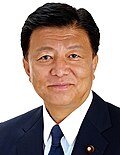 | Yoshitaka Shindo | R | 13 September 2023 – 1 October 2024 | |
|---|
Minister in charge of Economic Security
Minister of State for "Cool Japan" Strategy
Minister of State for Intellectual Property Strategy
Minister of State for Science and Technology Policy
Minister of State for Space Policy
Minister of State for Economic Security | |  | Sanae Takaichi | R | 10 August 2022 – 1 October 2024 | |
|---|
Minister of State for Okinawa and Northern Territories Affairs
Minister for Consumer Affairs and Food Safety
Minister of State for Regional Revitalization
Minister of State for Ainu-Related Policies
Minister for the World Expo 2025 | |  | Hanako Jimi | C | 13 September 2023 – 1 October 2024 | First cabinet appointment [28] |
|---|



